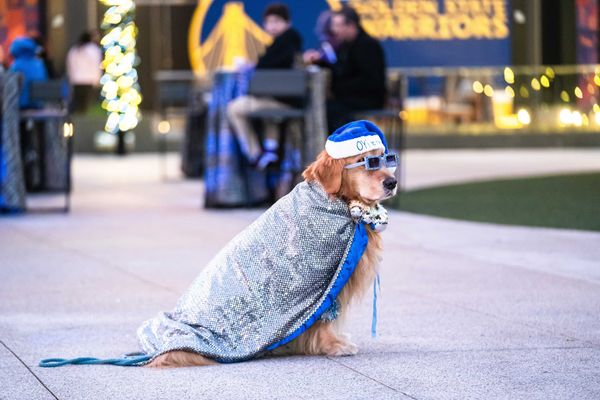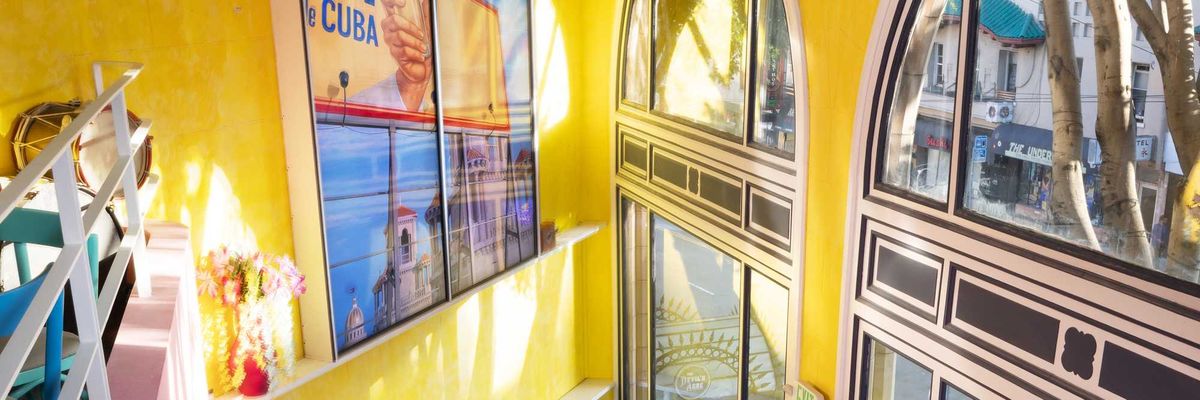For the first time in 30 years, the de Young is throwing wide the doors to a closet stuffed with a century of couture.
More than 100 pieces—little black dresses, elegant suits, strappy shoes, and more—are included in Fashioning San Francisco: A Century of Style, opening on January 20th. Visitors won't just view the garments at a distance at the exhibition, they'll have the chance to try them on. Augmented reality mirrors developed by Snapchat painstakingly recreate every detail of three of the designs on display, and perfectly drape them on bodies of all shapes and sizes.
Fashioning follows the development of SF style, beginning immediately after the devastation of the 1906 earthquake. Although fire destroyed the city's downtown retail district, within weeks of the tragedy shop owners banded together to open a temporary place to display their wares. It made the day's news when the first French-made designs returned to the city.
Some of these dresses, and others from the early 20th century, which include a 1924 drop-waisted, bead-strung, black-and-gold gown by French designer Jeanne Lanvin and a drapey 1932 lemon-sherbet-and-chartreuse evening dress by designer Jean Patou, were worn by and donated to the museum by the era's affluent SF women. They are just two examples, says Tom Campbell, director of the Fine Arts Museums of San Francisco, of the memorable ways in which "Bay Area women have fearlessly styled themselves” over the last 120 years.

From the garments that represent the height of fashion at the turn of the 20h century, the exhibition proceeds through six more curated galleries, starting with the style staple that the 1937 fashion editor of the San Francisco Chronicle considered “indispensable in most wardrobes:” the little black dress. Among the frocks on display is a long-sleeved, floor-grazing number Yves St. Laurent created for Christian Dior in 1955.
That year, St. Laurent’s LBD was included in a 14-page Harper's Bazaar story on Paris fashion. In 2024, you can try it on for yourself in the AR gallery, where stepping in front of a digital "mirror" triggers the garment to materialize Cinderella-style. (Pro tip: Take off your coats, jackets, and bulky sweaters before stepping in front of the mirror for the best results).
Valentino’s gold-toned, velvet paisley gown from the exhibition's formal wear gallery, which nods to the city's tradition of philanthropy, and a dark lamé dress by Kaisik Wong with a dramatic shawl collar and delicate Chinese-inspired embellishments from the exhibition's avant-garde gallery, have also been remade in the virtual fitting room. Although similar AR mirrors have been used in other museum contexts globally, this is the first time Snapchat has partnered with a U.S. museum to place visitors inside the exhibition. A built-in camera feature snaps a photo, then throws a QR code to deliver the image straight to your phone.

While fluttery, flowing gowns make up a big part of Fashioning San Francisco, there are also galleries dedicated to glamorous shoes in a variety of shapes and heel heights, and women's suits, a style that rose in popularity through the 20th century as a symbol of female agency. Designs from throughout the 20th and early 21st centuries appear side by side to emphasize the ways they have evolved over time.
In the final display, the exhibition takes on the question of cultural appropriation and commodification in fashion with garments that incorporate West African beading, Southeast Asian silhouettes, and other elements inspired by or outright stolen from non-Western communities. The appearance of the designs over the years in the wardrobes of SF women reflects the ethnic diversity that has shaped the city since its inception.
Clothing, says Laura Camerlengo, curator of Fashioning San Francisco and of costume and textile arts at the Fine Arts Museums of San Francisco, has always been a way to express individual identity. The de Young’s new exhibition reveals exactly how fashion has been “woven into the social and cultural landscape” of the city, and how it continues to define Bay Area diversity and style today.
// Fashioning San Francisco: A Century of Style is on exhibition at the de Young from January 20 through August 11, 2024; 50 Hagiwara Tea Garden Dr. (Golden Gate Park), famsf.org






















